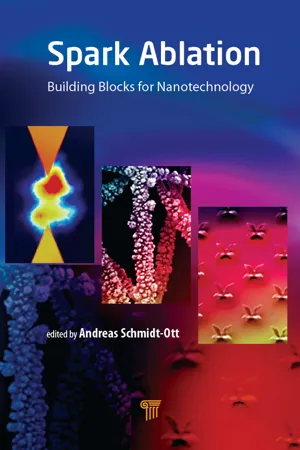
- 456 pages
- English
- ePUB (mobile friendly)
- Available on iOS & Android
About This Book
Spark ablation has been used worldwide for decades. However, in many fields, the special properties of nanoparticles, which come into play especially for sizes <20 nm, are just beginning to be exploited. The technique offers unprecedented flexibility regarding composition and size, and revolutions in the domains of catalysis and sensor technology, and more are to be expected. This book is the first review of spark ablation as a unique, scalable source of building blocks for nanotechnology and a powerful tool to promote this development. The introductory chapters give an overview of the technological fields that can exploit size effects, and explain the process of spark ablation in the gas phase, as well as principles of immobilizing particles to create novel products and materials. Fundamentals of the spark ablation process are then discussed, in addition to the characteristics of the particles formed. The rest of the book deals with a selection of application fields that profit from the spark ablation source from the perspective of research. With the authors' many years of experience in spark ablation and its applications, all the chapters complement one another and contain numerous cross-references in order to enable the reader to obtain a complete picture of the subject.
Frequently asked questions
Information
Chapter 1
Application Domains of <20 nm Particles and the Role of the Spark Discharge Generator
Eva A. J. Rennen,a Maurits F. J. Boeije,b and Andreas Schmidt-Ottb,c
1.1 Introduction
1.2 Sub-20 nm Particle Properties and Their Application Domains
1.2.1 Basic Size Effects
Basic category | Basic size effects of practical interest |
|---|---|
B1. Geometry or surface-to-volume ratio related | B1.1 Faster mass transport to surface of particle in medium |
B1.2 Faster mass transport from surface to center of particle | |
B1.3 Faster dissolution | |
B1.4 Reduced strain in volume expansion | |
B2. Reduced binding energy between atoms due to surface curvature | B2.1 Reduced melting point |
B2.2 Increased vapor pressure | |
B2.3 Faster dissolution | |
B2.4 Increased chemical reactivity | |
B2.5 Size-dependent catalytic activity | |
B2.6 Increased adsorptive binding of atoms/molecules | |
B2.7 Larger variety of crystal habits | |
B2.8 Laplace pressure inside nanoparticle | |
B2.9 Superplasticity | |
B2.10 Reduced surface free energy | |
B3. Quantum-mechanical size effects | B3.1 Size-dependent plasma resonance |
B3.2 Size-tunable bandgap in quantum dots | |
B3.3 Photoelectron emission enhancement | |
B3.4 Superparamagnetism | |
B3.5 Formation of “superatoms” | |
B3.6 Strong size dependence of light scattering and absorption | |
B3.7 Surface-enhanced Raman scattering (SERS) from adsorbed molecules |
1.2.2 Application Domains of sub-20 nm Particles
1.2.3 Requirements for Successful Applications
Table of contents
- Cover
- Half Title
- Title Page
- Copyright Page
- Table of Contents
- Preface
- 1. Application Domains of <20 nm Particles and the Role of the Spark Discharge Generator
- 2. Nanoparticle Production by Spark Ablation: Principle, Configurations, and Basic Steps toward Application
- 3. Spark Plasma Diagnostics
- 4. The Physics and Equivalent Circuit Modeling of Spark Ablation
- 5. Generation of Mixed Nanoparticles by Spark Ablation of Alloys and Spark Mixing
- 6. Characterization of Nanoparticles from Spark Ablation
- 7. Atomic Clusters: Potential of Spark Discharge Generation
- 8. The Use of Spark Ablation for Generating Cluster Beams: A Review
- 9. Patterned 3D Nanostructure Arrays from Charged Aerosols
- 10. Catalytic Applications of Nanoparticles Produced by Spark Ablation
- 11. Nanoparticles and Nanoparticle-Based Materials Produced by Spark Ablation for Environmental Gas Sensors
- 12. Alloy Plasmonic Nanoparticles and Their Applications
- 13. Spark Ablation for Biomedical Application
- 14. Application of a Spark Discharge Generator for Production of Combustion-Like Aerosols
- Index